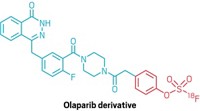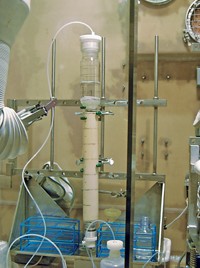Advertisement
Grab your lab coat. Let's get started
Welcome!
Welcome!
Create an account below to get 6 C&EN articles per month, receive newsletters and more - all free.
It seems this is your first time logging in online. Please enter the following information to continue.
As an ACS member you automatically get access to this site. All we need is few more details to create your reading experience.
Not you? Sign in with a different account.
Not you? Sign in with a different account.
ERROR 1
ERROR 1
ERROR 2
ERROR 2
ERROR 2
ERROR 2
ERROR 2
Password and Confirm password must match.
If you have an ACS member number, please enter it here so we can link this account to your membership. (optional)
ERROR 2
ACS values your privacy. By submitting your information, you are gaining access to C&EN and subscribing to our weekly newsletter. We use the information you provide to make your reading experience better, and we will never sell your data to third party members.
Physical Chemistry
Astatine is a chemistry puzzle that shows anticancer promise
Even with unanswered questions about the element, researchers think astatine-211 produces the right kind of radiation to treat cancers
by Sam Lemonick
August 13, 2020
| A version of this story appeared in
Volume 98, Issue 31

“I ask you,” the email to C&EN read, “is astatine more like a halogen or like a metal? This question awakens the inorganic chemist in everyone.” Whether or not you feel the same enthusiasm as the email’s author, Stosh Kozimor, a chemist at Los Alamos National Laboratory (LANL), it’s hard to deny that astatine is a particularly interesting element.
To start, it’s the rarest naturally occurring element on Earth. Its name comes from the Greek word for unstable, and its longest-lived isotope, astatine-210, has a half-life of just over 8 h. One textbook estimates that less than an ounce of astatine exists on Earth at any moment. That ephemerality means scientists still don’t know basic information about the element, like its boiling point or what color it is.
What’s more, as Kozimor points out, astatine resists easy chemical classification. While it sits in the column of halogen elements on the periodic table, it also lies on a diagonal line containing metalloids like boron and silicon. In reactions, it sometimes acts like a halogen, sometimes like a metal.
But astatine isn’t just a chemical curiosity. Groups around the world are investigating the isotope astatine-211 as a potential cancer treatment. That research, in part, has driven some chemists to want to know more about this elusive element.
Astatine is of interest as a cancer therapy because it is one of several elements that emit an α particle—a combination of two protons and two neutrons—when it decays. α particles tend to have more energy but travel a shorter distance than other forms of radiation. As a result, α particles can kill a cancer cell by slicing through both strands of its DNA, but the damage is limited to just a handful of cells near the particles’ source. By attaching astatine isotopes to molecules designed to target specific cancer cells, researchers could develop an anticancer therapy that should cause little damage to surrounding healthy tissue compared with current chemotherapy and radiation therapy options. “Nothing can even come close to having that same targeted potency” as α particles, Mehran Makvandi, a radiologist at the University of Pennsylvania’s medical school, says.
Astatine-211 is the isotope most likely to find clinical use. 210At decays to polonium-210, an extremely toxic substance notoriously used to murder former Russian spy Alexander V. Litvinenko in 2006. Meanwhile, 211At decays to harmless bismuth or to 211Po, which has only a half-second half-life. Other astatine isotopes are too short-lived for use as medical treatments.
According to Makvandi, 211At also has a few advantages over other α emitters like actinium-225 and lead-212. Actinium-225 emits four α particles, making it more potent than 211At, but that scatter shot of α particles can also break the bonds that hold 225Ac to the molecule carrying it to tumors. So 225Ac needs special chelators that can hold on to the isotope as it decays. 211At fires off just a single α particle, meaning there is a lower risk of it breaking free of its molecular holder and traveling elsewhere in patients’ bodies. Lead-212 is another α-emitting therapeutic candidate, but it also produces high-energy γ radiation, which poses a long-term health risk to medical staff. In terms of half-life, radiation, and chemistry, “astatine is the Goldilocks of α emitters,” Makvandi says.
Early-stage clinical trials have shown some promise for astatine-based therapies. Duke University chemist Michael R. Zalutsky showed that 211At attached to antibodies doubled the life expectancy of brain-cancer patients when administered after the patients had large tumors surgically removed (J. Nucl. Med. 2008, DOI: 10.2967/jnumed.107.046938). Zalutsky’s group has also adapted another radiotherapy drug, metaiodobenzylguanidine, by replacing the iodine-131, which emits another form of radiation, with 211At to make 211At-meta-astatobenzylguanidine (211At-MABG). Research groups at the Children’s Hospital of Philadelphia and Japan’s National Institute of Radiological Sciences are testing this small molecule in patients with different types of cancer.

Meanwhile, at the University of Washington, D. Scott Wilbur has led efforts to test astatine-based therapies on blood-borne cancers like leukemia and multiple myeloma. Cancer cells moving in the bloodstream are hard to target with external radiation therapy, making molecules that can target the cells and deliver an α emitter an attractive option.
Like others, Wilbur’s group has used antibodies and antibody fragments as the targeting molecules, but they have found it difficult to keep 211At attached in vivo. They have experimented with tagging antibodies, antibody fragments, and small molecules with aromatic boron cages that hold the 211At atoms (J. Med. Imaging Radiat. Sci. 2019, DOI: 10.1016/j.jmir.2019.03.012). In addition to being more stable, Wilbur says the reaction between 211At and the boron cage is faster and more predictable than attaching 211At to antibodies. For all these astatine therapies, a technician would need to assemble the drug from the isotope and its cancer-targeting carrier shortly before treating a patient. So speed and efficiency of assembly are important considerations when half of an α emitter will be gone in just 7 h.
Duke scientists have also had chemistry trouble with their astatine-antibody complexes. They stopped their trials in the early 2000s because they couldn’t increase the radiation dosage of their compounds without the increased radiation breaking bonds in the antibody and reducing their synthetic yield. The researchers have since developed an alternate procedure that emphasizes avoiding reductants and chemicals that can become reductants when irradiated—like chlorine radicals from chlorinated solvents—which interfere with 211At binding to antibodies (Cancer Biother. Radiopharm. 2020, DOI: doi.org/10.1089/cbr.2019.3204). With this new methodology in hand, they are now looking into trials involving molecules that can deliver higher radiation dosages.

These troubles with chemistry go back to one of the fundamental difficulties of astatine: it acts like both a halogen and a metal. In water, depending on the conditions, astatine can be a cation like a metal or an anion like a halogen, says Nicolas Galland of the University of Nantes. His group is at the forefront of experimental and theoretical investigations of astatine’s chemistry and properties. Galland was part of a group led by the European Organization for Nuclear Research (CERN) that recently measured astatine’s electron affinity for the first time (Nat. Commun. 2020, DOI: 10.1038/s41467-020-17599-2).
Astatine also has its own unique behaviors. Galland’s group calculated that in water, the compound AtO+ features astatine in a singlet spin state, but in the gaseous phase, AtO+ sports astatine in a triplet spin state.
Astatine’s short half-life makes experimental explorations of its chemistry difficult. But Galland says astatine makes theoretical work tricky too. Its innermost electrons move so fast that computer models must take into account relativistic effects, which complicate calculations.
But finding efficient chemistry to deliver 211At to tumors is only half the battle for chemists. First they have to make and purify the isotopes. Whether for basic research or medical trials, researchers use cyclotron particle accelerators to bombard bismuth-209 targets with α particles, starting a decay series that leads to 211At and other isotopes. The energy of the particles and the temperatures have to be controlled to get the right astatine isotope and prevent the target from overheating and vaporizing the astatine. Next, scientists have to separate 211At from the target and other decay products. Duke researchers use a dry distillation procedure, in which they heat the irradiated target to 650–800 °C and blow the vaporized 211At into a trap using an inert gas.
University of Washington researchers initially experimented with the same technique, but switched to a wet chemistry method because of problems when purifying large amounts and because they worried that radioactive material could escape the lab if filters and other safety measures failed. The wet chemistry method starts with dissolving the bismuth target in acid, then isolating 211At using a liquid-liquid extraction or chromatography.
Yawen Li, who is taking over the University of Washington’s 211At program as Wilbur approaches retirement, led a project to develop a column packed with tellurium metal, which adsorbs astatine under acidic conditions. Te columns can isolate 90% of the astatine from a solution in half the time a liquid-liquid extraction takes (Sci. Rep. 2019, DOI: 10.1038/s41598-019-53385-x). LANL’s Kozimor has developed his own column separation technique using a commercially available polymeric media (Inorg. Chem. 2020, DOI: 10.1021/acs.inorgchem.0c00221). Wilbur says the LANL technique shows promise, but hasn’t yet matched the yield of Te columns. University of Washington researchers have also been working with Matthew O’Hara at the Pacific Northwest National Laboratory to automate 211At purification, which could help protect chemists from long-term effects of radiation.
The dark horse for 211At production methods is through radon-211. 211Rn produces 211At as it decays, and the two are more easily separated than astatine and bismuth because radon is a gas. Radon also has a half-life twice as long as 211At. A container with 211Rn purified from irradiated bismuth targets could be shipped to a hospital, where a chemist would then extract 211At from the generator’s aqueous phase, according to Kohshin Washiyama of Fukushima Medical University, one of the researchers developing the technology.
Time is a constant worry for astatine researchers. Ethan Balkin, formerly of the University of Washington and now the program manager at the US Department of Energy (DOE) for isotope research and development, remembers that at his fastest he could purify a sample of 211At in 1 h and 20 min. His lab manager could do it in 1 h, and saving “that 20 minutes is gold” when you’re trying to get a sample for experiments or clinical trials, Balkin says.
The other thing astatine researchers are short on is funding. That’s partly because of the strange place astatine research occupies. Answering basic questions about the element’s chemistry and properties could help chemists develop better ways to purify its isotopes and use them against cancer or other diseases. Right now, there’s money for production and purification research and money for clinical studies, but there's little specifically for basic research on its chemistry.
The DOE isotope program exists to fund research on astatine production and processing. Currently, only Duke and the University of Washington produce enough 211At to supply researchers and doctors in their regions (the DOE does sell 211At and other isotopes through the National Isotope Development Center). The DOE wants to help other research groups, including Makvandi’s at the University of Pennsylvania, scale up their production so they can become regional providers as well, allowing more scientists to get involved in astatine research. But Balkin says the DOE program cannot fund research on 211At applications. A group that’s ready to do clinical work with the isotope needs to apply for US National Institutes of Health funding, Balkin says.
Wilbur says the result is a “valley of death” in the research funding landscape for developing new radiotherapy compounds. “There’s an area in there, where if you submit an application saying we want to evaluate the chemistry of this, it doesn’t get funded,” Wilbur says. He notes that there has been talk between the DOE and the NIH about setting up a program for more basic research. “Maybe it’ll get done,” he says.
Update
This story was updated on Aug. 17, 2020, to clarify that there is funding for research that helps scientists purify astatine but little for purely basic research into the element's chemistry.





Join the conversation
Contact the reporter
Submit a Letter to the Editor for publication
Engage with us on Twitter